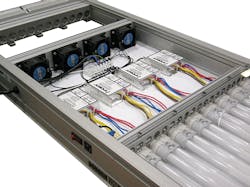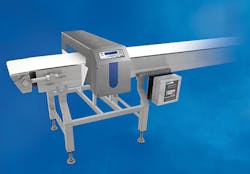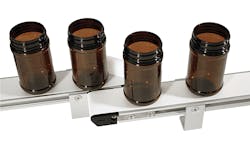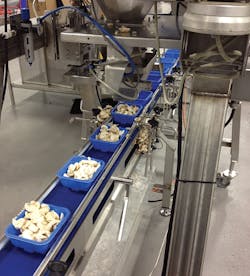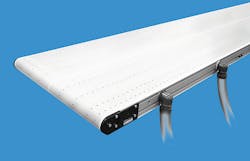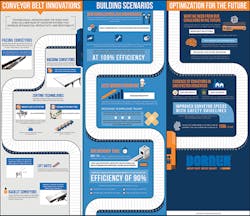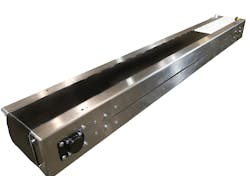This file type includes high resolution graphics and schematics when applicable.
If we could climb into a time machine and visit manufacturing facilities in the 1950s, we might be surprised at what we’d see in terms of conveyor belts: rather rudimentary conveyors simply moving parts from point A to point B through packaging and assembly (and just two kinds of conveyor belts—dirty and dirtier).
Today, however, manufacturing sites have changed, with conveyors becoming critical components for complex material handling applications, both for packaging and assembly. And engineers have developed a wide variety of belt and conveyor options, each designed for moving, inspecting, and processing specific products.
Recent trends in conveyor design and belting have increased throughput and productivity as systems are being tasked with performing much more diverse functions than their early predecessors.
A Smorgasbord of Conveyors
Advances in conveyors are letting engineers find more creative ways to use them in the machines they design. Here are some common capabilities conveyors bring to the table:
Backlighting. Backlit conveyors are ideal for visually inspecting products as the belt moves them through packaging or assembly. These machines have light fixtures installed at certain sections in the frame to illuminate items traveling on translucent belts. Various in-line machine-vision sensors mount over the backlit section for inspections.
The contrast created by light shining up between products lets sensors take good images, inspecting for defects or merely the presence or orientation of a product. The belt can be programmed to move continuously if the sensors can grab the data they need from moving targets. Alternately, it can be programmed to move stepwise, so that every section pauses over the backlit portion as detailed images are taken.
Pacing conveyors. Products sometime need to be aggregated or herded together on a conveyor line. Other times, applications require that products be spaced out along the conveyor belt. Pacing conveyors can accomplish both tasks by using more than one belt on the same line. An operator can then control product spacing, speed, and orientation, preparing products for machine-vision inspections or packaging, or getting a multi-conveyor layout to merge several lines.
Metal-free conveyors. Many applications in the food and pharmaceutical industries require that products pass through metal detectors before being packaged and shipped. To ensure the detectors don’t alert on the belt or its components, some conveyors use a metal-free belt, The conveyor’s steel bedplate is replaced in areas with metal detectors with ones made of Delrin, an inflexible polymer that resists heat. This lets the metal-scanning sensor check passing products without picking up false readings from the bedplate.
Sanitary conveyors. These conveyors feature welded, rounded frame members and minimal fasteners in the food zones to reduce catch points and help minimize the chances of contamination. These conveyors are also designed to withstand repeated high-pressure cleanings daily, and they can be fully disassembled for cleaning in just minutes. To avoid contaminating products due to poor machine design, the food industry is continually updating the regulations and standards for conveyors and other equipment. (Learn more about these new regulations.)
Vacuum conveyors. To keep smaller, lightweight product in place on belts for inspection, assembly, or packaging, some manufacturers use vacuum conveyors. These have belts perforated with small holes, in addition to bedplates featuring grooves along them. The grooves let a regenerative vacuum blower continually pull air through the belt and “suck” products down onto the belt. The vacuum blower’s capacity is determined by the total area of vacuum holes, as well as the pressure needed to hold products to the conveyor belt.
Miniature conveyors. Although most conveyors move average- to larger-sized parts, small items need to be moved as well. That role is best served by miniature conveyors. Moving small, lightweight fragile parts– such as those often found in medical devices–is a task perfectly suited for miniature conveyors. They have ¾-inch frame heights, letting them fit in tight, compact spaces. Due to their small size, however, these conveyors are difficult to build from scratch without sacrificing precision and consistency.
Conveyor accessories also contribute to the design flexibility engineers have when designing conveyor systems. For example, engineers can add shaft encoders to conveyor drive shafts to sense rotations, count pulley revolutions, and control the belt in feeding or indexing applications. Diverters and gates triggered by proximity switches, photo eyes, or counters can guide and change product direction, routing them to single or multiple locations. In addition, diverters and gates can meter flow to specific areas or separate products based on attributes.
Depending on the product and required stroke length, pushers can be mounted overhead or on the conveyor’s side to remove items moving along the conveyor. Servo drives accurately stop conveyors to ensure parts are exactly where they need to for inspection or to be picked up. They can also help control acceleration/deceleration and assist in assembly.
The Right Belt
Technology hasn’t forgotten about conveyor belts, either. Today’s engineers can choose from any number of conveyor belts and styles to suit most any application. Although many people tend to take belts for granted, there are major differences in the types available. Specifying the right one depends on several factors, all of which need to be taken into consideration. Among these are:
• The product being moved.
• The product’s size and weight.
• The conveyor’s speed.
• The conveyor’s operating environment.
• Product orientation on the belt.
• Turns and slopes on the conveyor.
For belts to perform well, they must track properly. Tracking refers to a belt’s ability to run true and straight on the conveyor frame and around the end rollers. If a belt isn’t tracking properly, it can run crooked over end rollers, affect operations, and lead to premature wear. Many factors affect tracking, including belt splicing, conveyor rollers, belt tension, side loads from pushing products on or off the belt, and debris built-up on the rollers.
To ensure belts track, some conveyor manufacturers add a V-guide strip of urethane down the middle of the belt’s underside. It fits into a V-shaped guide groove running down the center of the conveyor’s frame. The V-guide helps keep the belt centered and tracking properly.
The manner in which the V-guided urethane is attached can make a difference in the overall integrity of the belt. V-guided belts tend to be stronger when the urethane is applied before the belt is made. Many manufacturers opt to cut fingers into the belt, splice it together, and then flip it upside down to apply the V-guide strip. The problem with this process is that it leads to two potential failure points: the splice and the V-guide splice. By applying the guide prior to making the belt, it maintains its integrity and provides a seamless guide on the belt.
Another belt type that’s not as popular—but has specific advantages for the packaging, manufacturing, and automation markets—is the clipper splice belt. They use intertwined hooks held together with a wire hook. Clipper splice belts are easy to remove; users simply remove the locking hook and the belt comes apart. This design is well-suited for applications that have conveyors partially inside larger machinery or equipment where access to the belts can be difficult.
The conveyors of today are engineered to provide much higher levels of functionality and performance than those of years past. Moving forward, conveyors are expected to continue evolving to fulfill specific niche roles within material handling and packaging. Miniature conveyors are a good example of this. New developments in conveyor belting are under development, including the combination of plastic chain and roller balls to orientate products on the fly.
Mike Hosch, Director of Product Development
Dorner Mfg. Corp., Heartland, Wisc.
A Conveyor for Pacing and Spacing
Spacing and timing products for packaging requires conveyor systems that are responsive, accurate, and agile. To get the ultimate in spacing and pacing accuracy and consistency, engineers at Dorner Manufacturing Corp. teamed with their counterparts at Yaskawa, a manufacturer of AC drives and motion control devices. Now, just two years later, two prototypes of the all-new SmartPace conveyor are in field test and additional prototypes are being developed.
SmartPace prepares evenly spaced or alternating batches of product, depending on the application, to meet end-users’ product spacing needs. The conveyor tracks both leading and trailing edges of the products, so they do not necessarily need to be all the same size and shape to be gapped appropriately.
As randomly spaced products enter the conveyor, a photo eye detects product spacing. In response, the servo motor control varies the conveyor speed and junction placement to set in motion evenly spaced product. SmartPace is a completely non-contact system—using no guides, diverts, or plows—even when merging several lines together. Eliminating these accessories reduces the risks of damaging the product.
The key to SmartPace’s capabilities lies in its two conveyor belts within a single frame, which can be aluminum or stainless steel. The two belts let SmartPace operate faster than a typical one-belt set-up. SmartPace also gives users several FDA-approved belting options that feature maintenance-free V-guide belt tracking and endless splices, all of which let the conveyor smoothly transfer parts only three inches long.
SmartPace conveyor belt is 4 to 12 in. wide and 6-ft. long with 1.25-in. end-transfer rollers. Motors can be mounted on either side or both sides of the conveyor.
A maintenance free/lubrication-free composite drive chain moves the single conveyor junction. The chain consists of low-inertia Acetal links that support the product loads lets junction reposition quickly at fast speeds.
Two Yaskawa SGMGV-05 Servo Motors with 2:1 timing belt reduction serve as conveyor drive motors, powering 3-in. diameter urethane-lagged conveyor belt drive pulleys. A single Yaskawa SGMGV-13 servo motor with 4:1 right angle gear reducer drives the composite chain that positions the conveyor junction.
The system is controlled by a Yaskawa MP2300 IEC Motion Controller and 230 V, 1 phase input drive (three-phase, 230 and 460 V, 50/60 Hz versions available available) and includes a standalone control with user-friendly control panel that lets a technician program and implement product spacing and patterns. The conveyor also includes a built in safety control circuit and it accepts remote enable and run signals input.
When SmartPace debuted at Pack Expo International 2014, it was promptly named one of that year’s Top 10 Packaging Trends. As field testing continues, Dorner is further improving the prototypes with the goal of making the new technology available for customer purchase by the end of 2015. In addition, Yaskawa is developing a software “toolbox” that should make programming the SmartPace much more user friendly and cost effective for unique applications not currently supported.
This file type includes high resolution graphics and schematics when applicable.
